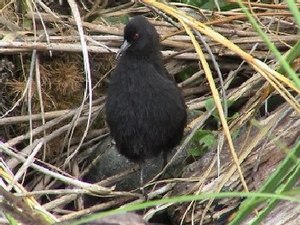Atlantis rail
| Atlantis rail | ||||||||||
|---|---|---|---|---|---|---|---|---|---|---|

Atlantis rail ( Laterallus rogersi ) |
||||||||||
| Systematics | ||||||||||
|
||||||||||
| Scientific name | ||||||||||
| Lateral rogersi | ||||||||||
| ( Lowe , 1923) |
The Atlantis rail ( Laterallus rogersi , Syn .: Atlantisia rogersi ) is a small bird from the family of the rails (Rallidae) and the order of the crane birds . It is the smallest flightless bird still alive .
description
The Atlantis rail occurs exclusively on the island of Inaccessible , which belongs to the Tristan da Cunha archipelago . In contrast to many other islands, no non-resident predators have been introduced on Inaccessible Island to date , which explains the stable population of the railing on the island. Many other flightless birds, including the even smaller St. Stephen's hatchback ( Xenicus lyalli ), have disappeared from similar habitats due to introduced predators.
The rail has an average weight of 40 g and an average length of 14 cm. It has a rust-brown back and a dark gray chest with a short black beak and red eyes (see illustrations). It populates the entire island, but grasslands and open fern bushes are preferred. Their diet includes worms , butterflies , fruits and seeds .
A clutch of mostly two eggs is laid between October and January. The chicks are attacked by predators such as B. the Tristandrossel ( Nesocichla eremita ), endangered.
Related species
The flightless Ascension rail ( Mundia elpenor ), which disappeared around 1700, was first mentioned and briefly described by the travel reporter and amateur naturalist Peter Mundy around 1656. The St. Helena rail ( Aphanocrex podarces ) disappeared before 1600 and could therefore never be scientifically recorded. The St. Helena rail was considered to be a close relative of the Atlantis rail. Since they have developed independently (the St. Helena rail is not strictly related), a separate genus has emerged from them . Both species were wiped out by the introduction of predators, mainly cats and rats .
Origin and origin
Since the island is 2,800 km from the South African and 3,200 km from the Brazilian mainland, it is unclear how the Atlantean rail was supposed to have got to the only island it lives on today. Theories that it flown in and only lost its ability to fly here in a geological period of hundreds of thousands of years or that it has always arrived with flotsam , always unable to fly , can be decided as little as the question of which continent (since neighboring islands are ruled out) Kind of immigrated.
More recent research on the second question by means of phylogenetic analysis of the DNA comes to the conclusion that the Atlantis rail is descended from the South American spotted swamphen ( Porzana spiloptera ) and, like the latter species, can therefore also be assigned to the genus Laterallus .
literature
- Martin Walters: The signals of birds - What birds reveal about the environment . Haupt, Bern 2011, ISBN 978-3-258-07682-9 .
Web links
- Atlantisia rogersi in the endangered Red List species the IUCN 2008. Posted by: BirdLife International, 2004. Retrieved on December 20 of 2008.
- Avibase record Atlantis rail ( Atlantisia rogersi ) Lowe, 1923
- Species factsheet: Atlantisia rogersi. BirdLife International, 2013, accessed February 24, 2013 .
- Spektrum .de: Secret of the »Atlantis« bird cleared November 2nd, 2018
Single receipts
- ^ Daniel Lingenhöhl: Secret of the »Atlantis« bird clarified on Spektrum.de from November 2, 2018.
- ↑ a b Martin Stervander, Peter G. Ryan, Martim Meloc and Bengt Hansson: The origin of the world's smallest flightless bird, the Inaccessible Island Rail Atlantisia rogersi (Aves: Rallidae) , in: Molecular Phylogenetics and Evolution, Volume 130, January 2019 , Pp. 92-98.
- ↑ Martin Walters: The signals of the birds - What birds reveal about the environment . Haupt, Bern 2011, ISBN 978-3-258-07682-9 . , P. 146.
